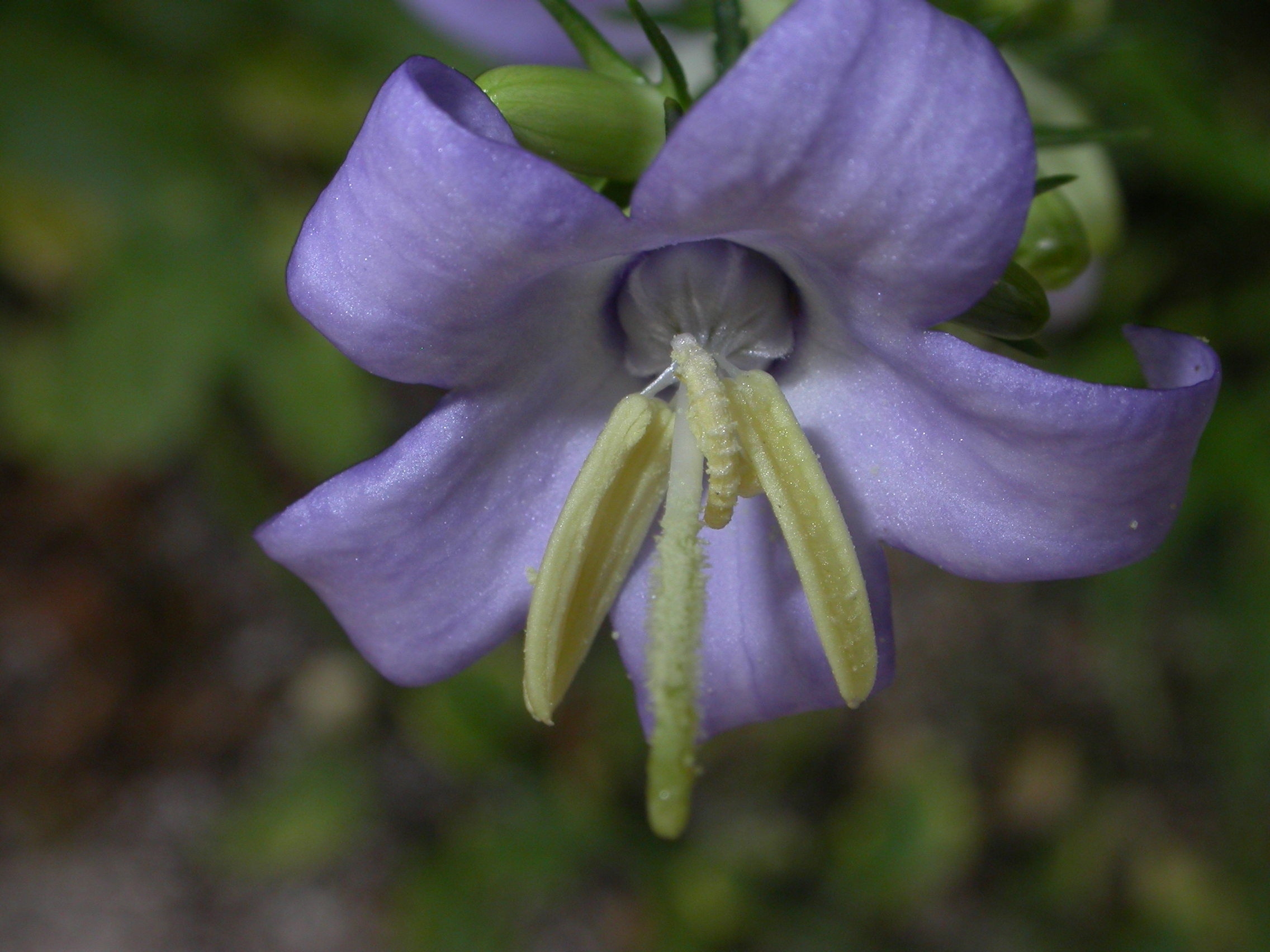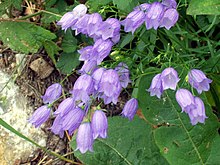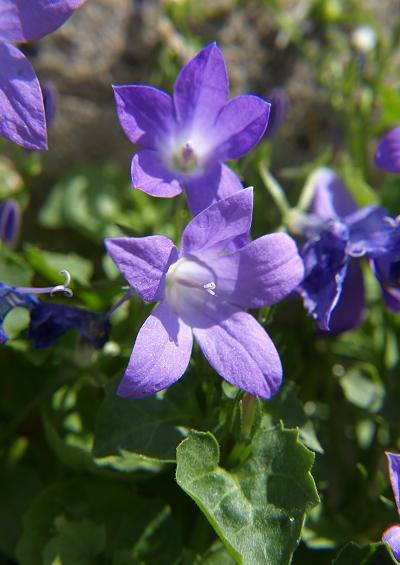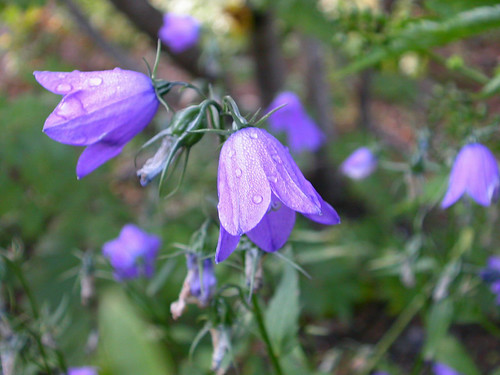Campanulaceae
Illustration of speculum - veneris Legousia with radial symmetry flower, Lobelia and dortmanna with zygomorphic flowers.
The Bellflower Family ( Campanulaceae ) form a family of plants within the order of the aster -like ( Asterales ). It has an almost worldwide distribution area. Some species and their varieties are used as ornamental plants.
- 3.1 Notes and references
Description
Appearance and leaves
They are mostly perennial or rarely annual herbaceous plants; rarely there are subshrubs, shrubs or trees. Milky juice is contained mostly in Stems and leaves, but also other parts of plants. They thrive when anchored submerged or emergent hydrophytes to xerophytes. Often rhizomes are formed as outlasting.
The undergraduate, or mostly alternate, rarely opposite or whorled arranged leaves sometimes have a leaf sheath, usually a more or less long petiole and leaf blade one. The leaf blades are usually simple and linear to circular, or simply by hand or pinnately lobed, or rarely assembled and then feathered. Most species have at most notched, toothed or serrated edge on small white glands. But they never have glands on the leaf surfaces. On one or both surfaces of leaves anomocytische stomata may be present. Stipules are never available.
Inflorescences and flowers
The flowers appear singly or lateral or terminal, sometimes on Blütenstandsschäften in simple or branched, zymösen, racemose, or aged men doldigen inflorescences together. There are leaves- leaf-like bracts reduced to present, rarely absent. In some species the inflorescence is a Pseudanthium, so a flower.
Most medium to large, hermaphroditic flowers are usually fünfzählig double perianth. There are both subfamilies with zygomorphen as well as those with radial symmetry flowers; one finds, for example, in Campanuloideae radiärsymmetrische and zygomorphe at Lobelioideae, resupinate flowers. In a few taxa a side cup is available. The usually five sepals are fused with each other and with the ovary ( not so with Cyananthus ) and there are usually five ( rarely three, four or ten) calyx teeth present. For example, in Campanula have the sepals at the base tag. The five petals are fused, usually two-lipped at the radärsymmetrischen often bell-shaped and at the zygomorphen and there are usually five (rarely four or ten) Kronlappen available. The colors of the petals range from most often shades of blue, even from white to yellow or rarely orange and pink colors to red and purple. There is only one ( the outer) circle with five fertile stamens present; they may be mutually free or fused, and they can be free from the petals or be grown near the Kronblattbasis. The dust bag can all be related, have two counters and they open with a longitudinal slot. The depending on the genus two - or three-cell pollen grains rarely have two, usually three to twelve apertures and are COLPAT, Porat, colporat ( colporoidat ) foraminate, or rarely rugat. Two, three or five carpels are fused to a two -, three -, five - or rarely zehnkammerigen by a false septum ovary; he is upper constant or continuously (see subfamilies). Sometimes the ovary is crowned by a ring-like or tubular nectary. The ovary chamber are included in most central angle constant placentation ten to fifty horizontal, anatrope, unitegmische, tenuinucellate ovules. Has at the upper end of the pens pollen- hair and ends in two, three or five scars. It is usually Proterandrie with a secondary pollen presentation.
The flowers formula is: or or
Pollination is by insects often ( entomophily ), but are often very specific mechanisms to promote cross-pollination developed, for example by special changes of the stylus or sterile tissue that covers the scars during anthesis.
Fruit and seeds
There are usually poricidale, septicidale or loculicidale capsule fruits formed, which open with flaps or in the genus bellflower (Campanula ) with holes for spreading of the many seeds. But there are the berries also taxa. The small seeds have a lot of mostly oily, starchy endosperm and rarely a straight, chlorophyll -less embryo with two seed leaves ( cotyledons ). The seeds can be winged or wingless.
Ingredients
In many taxa Inulin is detected. Polyacetylenes occur. Alkaloids are usually present. In Cystoliths leaves are often present.
System
The Campanulaceae family was erected in 1789 by Antoine Laurent de Jussieu in Genera Plantarum, p 163. Type genus Campanula is. Synonyms for Campanulaceae Juss. are: . Cyananthaceae J.Agardh, Cyphiaceae A.DC., Cyphocarpaceae Reveal & Hoogland, Jasionaceae Dum, Lobeliaceae Juss. nom. cons. , Nemacladaceae Nutt ..
The Bellflower Family ( Campanulaceae ) family is divided into five subfamilies and 85-86 genera with 2000-2300 species:
- Subfamily Campanuloideae Burnett: You have radiärsymmetrische flowers and Upper constant ovary. With 45 to 50 genera and about 950 species, global distribution: Adenophora fish. It is a monophyletic genus and contains about 62 species mainly in eastern Asia and is also sufficient to India and Vietnam. In Central Europe: Cup bell or bells lilies ( Adenophora liliifolia (L.) Besser Syn. Liliifolia Campanula L.): It is widely used and is the only species of this genus which is also found in Europe.
- Azorina vidalii Feer: It occurs only in the Azores.
- Berenice arguta Tul. It occurs on the Mascarene Islands.
- Cryptocodon monocephalus ( Trautv. ) Fed. It occurs in Central Asia.
- Cylindrocarpa sewerzowii ( rule) Rule: It occurs in Central Asia.
- Echinocodon lobophyllus DYHong: It is endemic in Staudengesellschaften on rocky sites at altitudes of about 300 meters only in Yunxi in the Chinese province of Hubei.
- Favratia zoysii ( Wulfen ) Feer: It is endemic to the south-eastern Alps.
- Feeria angustifolia ( Schousb. ) Buser: It is native to Morocco.
- Hanabusaya asiatica ( Nakai ) Nakai: It occurs only in Korea.
- Heterocodon rariflorum Nutt. It comes in western North America from British Columbia to California and Colorado before.
- Ordinary Turks bell ( Michauxia campanuloides L' Hér. ): It is native to Turkey, Syria, Lebanon and Israel.
- Michauxia laevigata Vent. It is native to Turkey, Azerbaijan and Armenia.
- Michauxia nuda A. DC. It is native to Turkey and Syria.
- Michauxia thyrsoidea Boiss. & Heldr. It is native to Turkey.
- Tschihatcheff Turks bell ( Michauxia tschihatcheffii fish. & CAMey. )
- Namacodon schinzianum ( Markgr. ) Thulin: It occurs in South Africa.
- Nesocodon mauritianus ( I.Richardson ) Thulin: It occurs only in Mauritius.
- Ostrowskia magnifica rule: It is native to Central Asia.
- Peracarpa carnosa ( Wallich ) Hook. f & Thomson: It is found in India, Bhutan, Nepal, Myanmar, China, Korea, Thailand, Papua New Guinea, in the Philippines, Japan, and Sakhalin.
- Petromarula pinnata (L.) A.DC.: It occurs only in Crete.
- Physoplexis comosa (L.) Schur: It is native to southeastern Europe.
- Balloon flower ( Platycodon grandiflorus ( Jacq. ) A.DC. ): It is native to eastern Asia and is used worldwide as ornamental plants.
- Rhigiophyllum squarrosum Hochst. It is native to South Africa.
- Blue neck herb ( Trachelium caeruleum L., Syn: Trachelium azureum Gouan ): For some authors, it is also the only species with two subspecies Trachelium caeruleum L. subsp. caeruleum and Trachelium caeruleum subsp. lanceolatum ( Guss. ) Arcang .. With a presence in the Mediterranean.
- Trachelium lanceolatum cast. It is endemic to the Iblei in Sicily.
- Trachelium × halteratum ( ex Bianca Ces, Pass & Gibelli. . ) Sandwith: It is a natural hybrid of Sicily. Sometimes a synonym of Trachelium caeruleum.
- Treichelia longibracteata ( H.Buek ) Vatke: It is native to South Africa.
- Subfamily Lobelioideae Schönland: You have zygomorphe flowers and under constant ovary. They have a worldwide distribution, but most species are tropical, a focus of biodiversity is the Neotropics. With about 29 to 32 genera and about 1200 species: Apetahia Baill. With about four species in the Pacific.
- Brighamia A.Gray: With only two species only in Hawaii: Brighamia insignis A. Gray
- Brighamia rockii H.St.John
- Dielsantha galeopsoides (Engl. & Diels ) E.Wimm. It occurs in West Africa.
- Grammatotheca bergiana ( Cham. ) C.Presl: It occurs in Australia and South Africa.
- Heterotoma lobelioides Zucc. It occurs in Central America.
- Hippobroma longiflora (L.) G.Don: The original home is located in Jamaica, she is wild in many tropical and subtropical areas of the world.
- Howellia aquatilis A. Gray: It is native to western North America.
- Mote Valdiviana ( Phil.) E.Wimm. It is native to western North America and southern South America.
- Ella Palmer debilis A. Gray: It is native to western North America.
- Porter Ella carnosula ( Hook. & Arn. ) Torr. It is native to western North America.
- Trimeris scaevolifolia ( Roxb. ) Mabb. This endangered species is endemic to the island of St. Helena.
- Unigenes humifusa ( A.DC. ) E.Wimm. It occurs in the Capensis.
- Nemacladus Nutt. With about 13 species of the southwestern United States to northern Mexico.
- Paris Hella A.Gray, with only one type: Paris Hella californica A. Gray: It is native to California.
- Pseudonemacladus oppositifolius ( BLRob. ) McVaugh: It is native to Mexico.
- Cyphia PJBergius: With about 50 species in Africa (mainly in the southern part ) and on the Cape Verde Islands.
- Cyphocarpus Miers: With only three species in Chile.







